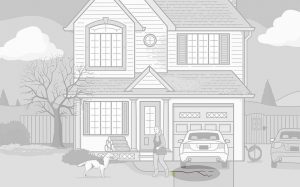If you’re looking to buy a home in and around Austin, Texas this fall, we have two words for you: Good Luck! The Austin real estate market is always as hot as our notorious summers, but the COVID-19 pandemic has added a competitive edge to the situation. Record low inventory combined with sky high demand creates a true sellers’ market.
While it’s not uncommon for multiple offers to result in a bidding war, we are seeing homes sell for $20-50,000 over their listing price this season. Even though we’ve been in the home inspection business for nearly 20 years, we are seeing things we’ve never seen before. Because many buyers fear they will not be able to get their desired property, they go in over asking price and with two-to-three-day option periods. To give you an idea, this time last year we saw an average of 14-21-day option periods.
As buyers make “as-is” purchases to secure their dream home, they sometimes ignore or even discard the home inspection report. Don’t make this mistake! The report is an investment in the life of your home and covers important facts you may have questions about in the future. Where’s your water heater? Look in the inspection report! How old is the HVAC? Look in the inspection report! You get the picture.
Take a tip from Randy’s toolkit and read the dang report! At the very least, you’ll learn about the status of your foundation, roof, and heating and cooling system which can help prepare for expenditures down the road.
Remember, at Barfield Home Inspection, we are licensed, trained and insured professionals who take your home inspection seriously. We don’t sugar coat things – we tell it like it is for the safety of you and your home. Follow us on Facebook and Instagram @BarfieldHomeInspection for more home maintenance tips from the company that’s been telling it like it is since 2003.

As if there wasn’t enough to be concerned about in 2020, it’s officially time to warn you: the bugs will be here soon, if they haven’t arrived yet! Thankfully, we aren’t talking murder hornets (although we advise you to be on the lookout!). While Texas is home to some real creepy crawlers, think the brown recluse, tarantula, and Texas redheaded centipede, ants and mosquitoes are more common. Even docile pests can be a nuisance to your health and your home.
Summer is peak for pests. Between warm (hot!) weather, doors opening and closing more often due to activities, and barbecues, your home may be more susceptible to pests during this time. Insects like ants, spiders and cockroaches may visit in search of food and water. In addition to spraying for pests or hiring a pest control service, follow these tips to secure your home’s perimeter and ward off crawling, flying and munching invaders:
• Clear the debris. Trash, leaves, lawn clippings and clutter around your yard can create a literal breeding ground for insects and a safe haven for other pests like snakes (eek!). Clean your gutters and keep these spaces clean to show these villains they are unwelcome.
• Seal them out. Seal any cracks and large openings around your foundation, water and gas pipes, windows, doors and cable lines. A quick shot of clear sealant will help to keep the pests out and your cool air in.
• Close your doors – tightly. In addition to keeping exterior doors shut as much as possible, make sure your weather sealing is in good, tight condition. If you find yourself constantly running in and out to manage the grill or hop in the pool, invest in an inexpensive mesh screen door to keep the villains out.
• Go with the flow. What’s your home’s biggest enemy? Water! By eliminating water sources, you’ll help deter bugs and preserve your foundation. Consider using stone or cedar mulch close to your house. Check outdoor faucets for leaks and use gutter downspouts to help water flow away from your home.
• Give it a trim. Insects get hungry, too! Trim limbs and shrubs that grow close to your home, as these provide food sources, refuge and runways to your home for tiny critters.
These easy-to-follow weekend warrior tips can save you time and literal pain down the road. Keep the pests at bay and your home safe this summer. For more home maintenance tips and tricks, be sure to follow us on Facebook and Instagram. Stay healthy, cool, and safe out there!
In this episode of Under the Roof with Randy Barfield, we are joined by agent and broker Kinan Beck of Austin’s One Source Team. Together, Randy and Kinan dive into the intricacies of today’s market and cover what buyers and sellers need to know.
Let’s face it – many of us have been indoors, or at least at home, for a while now. For sellers prepping to list this spring and summer, here are a few of Randy’s top tips to get your home ready while you wait.

Dear Friends,
Our deep Texas skies and budding bluebonnets herald the message that spring will soon be here. However, the coronavirus (COVID-19) is top of mind for all of us, especially those in the process of buying and selling their homes. We want to reassure all of our clients, realtors, home buyers and sellers of the precautions we are taking to protect you in the midst of COVID-19.
At Barfield Home Inspection, we pride ourselves in providing customers with the highest quality of service at all times. As a home inspection team, we enter homes with care each day and are responsible for testing and coming into contact with numerous items in each home. Our commitment, like our Texas heritage, is unwavering. During this time, we are taking thoughtful steps to reassure our clients’ comfort, while providing the same impeccable quality of trusted service we are known for.
Here are a few things you can expect to see from our team in the coming weeks:
- We will continue to wear boot covers and gloves as part of our normal inspection routine. We also wear face mask respirators in areas such as attics and crawl spaces. The newly recommended protocols for health awareness are nothing new to us and we will continue to use these precautions to protect our health, our clients and their homes.
- Hand sanitizer is also a standard part of our uniform, and we sanitize our hands regularly. We know that gloves are not a substitute for clean hands, and we wash and sanitize as frequently as possible.
- No handshakes, we will greet you with a smile instead. Given the recent recommendations from the World Health Organization (WHO) and the Centers for Disease Control and Prevention (CDC), we will not extend our hands until the spread of contagion dissipates. Instead, look for your home inspector to offer an elbow, nod or even a foot bump as a courteous way to say hello!
We understand that this is a challenging time for everyone and appreciate your continued partnership and trust. Feel free to get in touch with any questions or concerns about our home inspection process. Visit the CDC website for the latest updates and information to protect your home and loved ones.
From our house to yours, we wish you safety and well-being. Stay healthy out there,
– Randy Barfield

Daylight saving time kicks off this weekend, and although we aren’t excited about the loss of precious sleep, we are looking gratefully forward to longer days, bright sunshine and warm Texas spring weather. While you’re busy checking your smoke and carbon monoxide detectors, this is also a great time for sellers in Austin’s competitive real estate market to ready their home for buyers. Although it’s still a bit early to plant flowers, here are a few tips to spring forward in your home sale:
- A clean, sparkling home will invite buyers and direct attention to all the right spaces. Start by cleaning your windows, inside and out, and wash your blinds to make an instant eye-opening difference. While you’re poking around the eyes of your home, be sure to inspect the weather stripping and caulking, which may be in need of repair.
- Showcase the exterior of your home by mowing the lawn. A fresh cut will help remove leaves and other debris, leaving your yard clean and fresh. This is also a great time to cut back hedges around your home to maximize bright sunshine indoors. Visit the Central Texas Gardener for specific tips and tricks that can help boost your home’s curb appeal this spring.
- Lower your gaze and take a long, hard look at your floors. The appearance of your floors can leave a lasting impression on prospective buyers, and you want to be sure it’s the right one! Start by vacuuming and mopping, but consider a professional cleaning or refinishing if needed.
In Austin’s hot market, buyers need to be as amply prepared as sellers. Here are a few tips for those looking to move into a new home this spring:
- Know your credit score and budget. Our friends in the mortgage lending business will tell you this is a crucial part of the process. If you need help finding a lender, give us a call – we know excellent professionals who would be delighted to help you along your home-buying journey. Be sure to factor in closing costs, property taxes and insurance.
- Once you are committed to buying in the upcoming months, contact your lender to get preapproved for a mortgage loan. While this is not a commitment or rate guarantee, getting preapproved will speed up the process down the road (which could give you the edge in a competitive market!).
- Know who you want to work with. The right real estate agent and mortgage lender can make the process much less stressful and more enjoyable. Be sure to work with individuals who understand your needs, wants and priorities. When you’re ready to purchase a home and need an inspector you can trust, call Randy Barfield and the Barfield Home Inspection team. We’ve been telling it like it is since 2003 and would love to help you into the home of your dreams.
For more home buying, selling, maintenance and inspection tips, follow us on Facebook and Instagram and tune into our new podcast “Under the Roof with Randy Barfield,” now streaming on Spotify and Stitcher!
Looking ahead to fall, there seems to be a new housing trend on the rise. More and more people are moving to the ‘burbs! Thanks to improvements in infrastructure and new roads, the suburbs are becoming increasingly more accessible. Not to mention, living outside the city means more wide-open space and less hustle and bustle.
Although construction around town can be irritating, these improvements are paying off for the Austin and its surrounding areas. Check out the article below from CBS Austin to learn more about the rise in ATX suburb homes.
New home starts in ATX suburbs near record pace driven by road construction
CBS Austin | By Fred Cantu
(Originally published on July 25 on CBS Austin News)
 Just like a typical Central Texas summer, the local real estate market continues to be hot. And the forecast for new home sales for the rest of 2019 is expected to end up comparable to 2018, but with more sales happening outside Austin. More people are choosing to buy their new homes outside Austin, not just because there are still wide-open spaces out there but because there are wider freeways to get you there.
Just like a typical Central Texas summer, the local real estate market continues to be hot. And the forecast for new home sales for the rest of 2019 is expected to end up comparable to 2018, but with more sales happening outside Austin. More people are choosing to buy their new homes outside Austin, not just because there are still wide-open spaces out there but because there are wider freeways to get you there.
New home sales in Central Texas are so strong right now developers can’t keep up with demand. Vaike O’Grady, Austin regional director for MetroStudy, adds, “We had a spike in home closings which is really interesting because it shows a strong demand in Austin.”
Areas developing as fast as they can include the communities of Liberty Hill, Cedar Park and Leander in Williamson County. O’Grady explains, “Williamson has really grown the most, and part of the reason for that is because they really invested in transportation in Williamson County, and people will go where they can find an easy commute.”
And you’ll get no argument from Williamson County Judge Bill Gravell. He says, “Williamson County I think is the most forward leaning county in Texas when it comes to the infrastructure that helps residents move from point A to point B.”
Hays County is also working to improve access to the interstate… and it’s paying off. Hays County Judge Ruben Becerra notes, “One of the biggest development areas in Hays County are the cities of Buda and Kyle in our I-35 corridor. So it’s no accident people want to live near where they can get on the roadway.”
Even with all the demand, builders had a 7% drop-off in the number of new home starts. But they say it was due to a shortage of available lots, a problem that they say has been addressed. O’Grady explains, “We had record lot deliveries during the quarter, so this supply problem is likely short term because developers worked really hard on to put lots on the ground. And the good news is those lots are going in where we really need them.”
##
Originally published by HouseLogic
By: Leanne Potts
Spot the 9 Problems With This House (Advice for New Homeowners)
Telltale signs you’re flubbing homeowner maintenance, like parking on grass.
You’ve closed on your first home. You got your keys. You got your rose-colored glasses. When you’re a new homeowner, excitement, optimism, and simply not-knowing-what you-don’t-know can make you look right past big problems in plain sight.
Discover some advice for new homeowners with this illustration of a home that has nine maintenance problems. Can you spot all nine? All Images: HouseLogic
All Images: HouseLogic
Find out if you’re right. Here are the answers:
#1 Tree Limbs Leaning Over the House
Yes, trees are lovely and shady, and they keep your house out of the sun. But they can also break off in a storm and fall on your house faster than you can say, “Hello, insurance company, there’s a hole in my roof!”
Those limbs can be a highway into your home for pests like raccoons and squirrels who might end up nesting in your attic or gnawing electrical wires. So keep limbs trimmed at least six feet above the house.
#2 Overgrown Grass

Holy moly, who knew grass grows so quickly?! But putting off mowing because you can’t find the time or don’t have a mower yet can come back to bite you.
Long grass makes a great hiding place for rodents, who will hang there until they get a chance to scurry into your house. When the lawn mower’s away, the mice will play — and you risk a city fine for overgrowth. Avoid the risk, and just whack that grass.
#3 Flaking Paint

Paint on your home’s wood or stucco siding is the deflector shield of your house. If it’s flaking, there are holes in your shield, and that’s a problem. It lets in moisture that can rot the bones of your home. A little water turns into big trouble, fast. The more water that seeps in through those cracks, the bigger the cracks get, letting in even more water.
So paint. Pronto.
#4 Wood Pile Near the House

You’ve got your entire winter supply of firewood stacked right up against the house, so you’ll never have to schlep wood in single-digit temps again. But. That woodpile can be a cozy winter home to a who’s who of unwelcome critters like mice, termites, and cockroaches.
Firewood storage outside should be at least 20 feet from your house. You can still keep a few logs near the door — just enough for a night or two. That way, your firewood stays handy, and the creepy crawlies don’t have time to move in.
#5 Parking on the Grass

You’re house-proud, so you have your friends over all the time. But if you let them park on the lawn (your house, your rules, right?), the vehicles will sink into the yard, compact the soil, and crush the grass.
Crushed grass becomes dead grass; weeds sprout in the dead spots; and soon your dying, weedy, tire-rutted yard starts chipping away at your house pride (and your home value).
If you need more parking, expand your driveway.
That’s better for curb appeal than a dead lawn.
#6 Moss on the Roof or Siding

Yes, it’s pretty and gives your house an enchanted-cottage look, but it will inflict damage to your home that will cost a small fortune to repair. Moss stores rainwater, causing mold to grow on the roof where it will seep into the wood beneath the shingles, into the attic, and then on indoor walls. Mold in your house = an allergy nightmare.
All that moisture will rot your roof, too. Same with mossy siding: water damage and mold await. Scrape that moss off as soon as you see it.
To prevent it from coming back, put zinc or copper flashing at the roof’s peak. Rain dissolves a bit of the metal every time it falls, and it kills moss when it washes over the roof. To get moss off siding, use a power washer.
#7 Debris In Gutters

Clean out those gutters. It probably won’t be the high point of your weekend, but it’s worth it.
When your gutters are full of leaves, sticks, and other gunk, they’ll overflow when it rains, pouring water on the fascia and soffit (the parts of your house under the eave), eroding landscaping, or even making your roof leak.
Clean-gutter bonus: You’ll have fewer mosquitoes, who lay eggs in the water in clogged gutters. So clean them. Or hire someone to do it.
#8 Cracks in the Driveway

Melted snow will seep into driveway cracks, then freeze, expand, and make the cracks even bigger. That ice can even push up chunks of concrete, leaving you with a driveway disaster. In the fall, patch cracks with concrete to keep winter water out. Asphalt driveway? There are products to patch that, too.
#9 Leaves Left on the Lawn

When you’ve put the mower away for the year and snow’s just going to cover your lawn in a month anyway, why bother with the leaves?
Your lawn may be done growing for the year, but its roots are alive and well. Leaving leaves on top of it can smother the grass and cause mildew, which will kill your yard. Then when spring comes, your lawn will stay brown.
To avoid this, rake up the leaves in the fall. Or, if there’s not an overwhelming amount, just run the mover over them. Collect them in your mower’s bag, or let the tiny bits mulch your lawn.
By Ray Boss Jr. | Contributor, U.S. News & World Report
(Originally published on Oct. 18, 2016 in U.S. News & World Report)

Attend the home inspection to learn more about the property you’re interested in buying. (ISTOCKPHOTO)
Throughout the homebuying process, you will encounter a number of expenses including, but certainly not limited to, an appraisal, transaction fees and a survey – but none is more important than the home inspection. Dollar for dollar, there is no better use of your money, as a home inspection will not only outline the strengths and weakness of the house you are buying, but will show you how to operate it.
Choosing the Right Type
When you sit down with your real estate agent to prepare your offer, he or she will go over the different types of inspections you can choose from. While there are different inspection options – radon, pest and mold, among others – you first want to steal with a standard home inspection.
There are primarily two different types of home inspections – the home and general inspection (the names may differ depending on your location). There’s no difference in the way the inspector approaches the property or with the report he generates – it’s how that information is used that makes it unique.
A home inspection is arguably the more classic option. Based on the report you receive, you will send a notice to the seller asking for either certain items to be fixed prior to settlement, or a dollar amount be credited toward your closing costs.
The general inspection, on the other hand, is for informational purposes only. While it allows you a full inspection and often gives you the right to walk away based on those results, it does not provide an opportunity for items to be fixed or a credit given in negotiations.
Choosing Your Inspector
Every individual involved in the homebuying process must be top-notch. This is likely the biggest investment of your life and understanding what you are getting yourself into is of the utmost importance. With this in mind, be sure you choose a tried and true inspector you can trust to overlook nothing and provide your report in a timely, organized manner.
The first person to talk to for referrals is your real estate agent. Most agents have likely encountered the good, the bad and the ugly of the home inspecting world and found a few professionals they trust. Make sure your inspector is actively licensed and a member of a trade association, like the National Association of Certified Home Inspectors or American Society of Home Inspectors, and other local professional groups. Members of professional organizations are often held to a higher standard and have gone through more rigorous training to be associated with an industry group.
Finally, ask if the inspector will allow you to see a sample inspection report. While you’ll receive all the information during the time of the inspection, the sheer amount of details can be overwhelming. Seeing a report in advance helps to prepare you for the information to come, and how it can be used as a negotiation and recordation tool as well.
Owner’s Manual
Whether this is your first home or 10th, each house offers its own quirks and there’s no owner’s manual provided. It’s highly recommended you attend the inspection, as the inspector will provide useful information throughout the process of not only the pros and cons of the property, but show you how everything works as well.
An inspector will give you a plethora of information, from which way to point your air filter to where the main water shutoff valve is and how old all your major systems are. While the age and condition of many systems and appliances will be noted in the report, an explanation of how to use everything isn’t standard in written form. Bring a notepad and jot down useful information throughout the process.
Using the Report
After the inspector has gone through the entire property and provided the report, take time to review it carefully and ask any questions to either your agent or the inspector so you fully understand what you’re reading.
As you read the report, it’s important to remember the inspector is acting as a primary care physician, and should anything need further evaluation you’ll be referred to a specialist. If the home inspector finds evidence of mold or a pest problem, for example, they’ll recommend to you talk to a mold abatement specialist or exterminator to discuss the work needed to alleviate the problem.
Every negotiation is unique and should be handled as such. That said, there are general guidelines when handling a post-inspection negotiation. First, if there are any major components that are obviously broken and in need of major repair or replacement – such as heating and cooling systems, roof and windows – go after those and don’t sweat the small stuff. You want to make sure you take care of the important items that are needed for your house to function optimally.
If there aren’t any major items to take care of, it’s time to sweat the small stuff. Create a list in order of what you consider most important to least, and present it to the sellers and make sure they understand where your priorities lie.
Finally, if you prefer to oversee the repair or update work yourself and opt for a credit from the seller, make sure you’re able to ask for the amount per the guidelines of the loan by consulting your lender. There is typically a percentage (commonly 3 to 6 percent) you are allowed to receive in total credits. Should the amount be in excess of what you need, you simply won’t receive it and it goes back in the seller’s pocket.
Keep in mind … It is important to remember several things during and after your inspection. First, inspectors can’t see through walls. While their inspection is certainly thorough, it does not include things they can’t see. Also, an inspection assesses the property as it is that day. Things change, and so do the components within the house.




